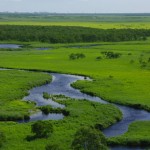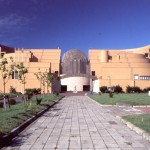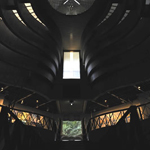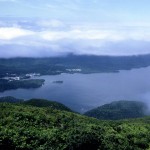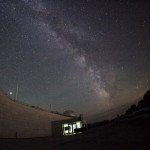鶴見台Tsurumidai
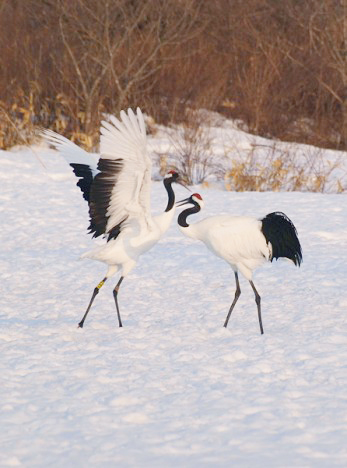
Photo: Yuji / CC BY SA 2.1
Red-crowned Crane is named after as it looks like wearing a red crown on top of the head. Designated as special natural treasure, Red-crowned Crane makes its habitat mainly in the east of Hokkaido including Kushiro Marsh頭頂部に赤い帽子を冠っている様に見えることからその名がついたタンチョウ(丹頂)は、特別天然記念物に指定され、主に北海道東部の釧路湿原などに生息。世界的に絶滅危惧種とされ保護対象となっている。先住民族のアイヌ民族には「サルルンカムイ(湿原の神)」と呼ばれているほど、気高い美しさを持っている。
![]()
鶴は「鶴は千年」という言葉があるほど長寿のイメージがあり、縁起が良いとされている。東洋美術において松などと共に描かれることも多く、花札の図柄や、旧千円札にも描かれている。歌川広重も「名所江戸百景」に描いていることから、以前は本州で越冬していたことが見受けられるが、現在は本州には生息していない。
![]()
野生のタンチョウは、明治時代に乱獲され、一時は絶滅したものと考えられていたが、1924年に釧路湿原で生存が確認された。そして給餌の先駆者・山崎定次郎氏により餌付けが行われる様になり、徐々に個体数を増やしていった。その餌付けがみられるのがここ、鶴見台である。給餌は渡辺トメ氏が40年にも渡って続けている。
![]()
給餌は朝と午後の2回。11月から3月までが見頃で、特に1月から2月にかけては180羽以上が集まることもある。冬の道東は大変寒いのだが、白い雪の中にたたずむタンチョウは見物である。赤い帽子が映えることだろう。また、春先に繁殖期があり、ジャンプしたり羽ばたいたりする姿が美しい「求愛ダンス」をする。
![]()
釧路近郊で、野生のタンチョウを見ることができるのはこの他、もうひとつの給餌場であるタンチョウサンクチュアリ、タンチョウの寝床である音羽橋やそれを一望できる丘などがある。また鶴見台に沿った「たんちょう舞ろーど」では、運が良ければ夏でもタンチョウが空を舞うところを見ることができる。
![]()
また、タンチョウを保護育成している釧路市丹頂鶴自然公園や阿寒国際ツルセンターなどの施設もある。またツルセンターがある、あかんランド丹頂の里ではゴルフや温泉などのレジャーも楽しめる。
![]()
十数羽の状態から約1.000羽まで生息数を回復させたタンチョウだが、生息環境の変化に加え、人間や地球温暖化などがもたらす環境変化により、タンチョウと人間の新たな関係を考える時期を迎えている。
![]()
鶴見台
住所:北海道阿寒郡鶴居村鶴見台下雪裡
TEL:0154-64-2114(鶴居村役場)
http://www.vill.tsurui.lg.jp
![]()
Text: Tamami Kadowaki. It is also listed as a endangered specie and is protected by law. As the indigenous ainu people call it as “the god of marsh”, the Crane has noble beauty.
![]()
It is known as a symbol of longevity, luck. In the eastern art, crane is drawn as a motif with pines. As Hiroshige Utagawa, a ukiyoe artist, once depicted the Crane on his famous One Hundred Famous Views of Edo, the Crane could be inhabited in the main land Japan, but currently it doesn’t.
![]()
The wild Red-crowned Crane was regarded once as threatened with extinction because it has been over-hunted in the Meiji era, but it was identified by its existence in Kushiro Marsh in 1924. And the feeding pioneer Mr. Sadajiro Yamazaki started to feed them and that increased the population of the Crane little by little. The feeding place will be here in Tsurumidai. You can see the view of feeding by Tome Watanabe who has been feeding over 40 years.
![]()
It was fed one each for morning and afternoon. You will experience the best view from November to March. If you are lucky enough, you can view more than 180 Red-crowned Crane during January and February. Quite chilly in the east of Hokkaido in the winter, it is worth to see beautiful Red-crowned Crane standing on the white snow field. In the spring time, you might be able to see their beautiful “love dance” soaring wings.
![]()
Near Kushiro, there is another feeding place Tancho Sanctuary where you can see wild Red-crowned Crane. In Tancho Sanctuary, there is a hill where you can view Otowa Bridge which is a sleeping place for Red-crowned Crane. On the Tancho-mai-road which runs along with Tsurumidai, you can see they are flying even in the summer, if you are lucky.
![]()
There are other institutions including Kushiro Red-crowned Crane Natural Park where protects and nurtures Red-crowned Crane, Akan International Crane Center. You can also enjoy visiting a Crane center as well as golfing and a hot spring at Akanland Amusement Park.
![]()
Even though the number of the population was drastically increased from a few dozens to about a thousand, we are now confronting to a time to reconsider our new relationship between human and Red-crowned Crane, because of the environmental change caused by us and global heating.
![]()
Tsurumidai
Address: Tsurumidai, Tsurui-mura, Akan, Hokkaido
Tel: 0154-64-2114
http://www.vill.tsurui.lg.jp
![]()
Text: Tamami Kadowaki
Translation: Mariko Takei鹤见台
地址:北海道阿寒郡鶴居村鶴見台下雪裡
电话:0154-64-2114(鶴居村役場)
http://www.vill.tsurui.lg.jp
